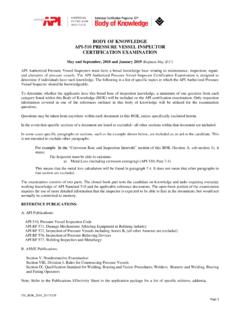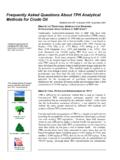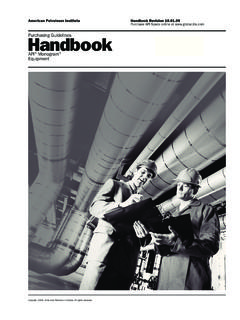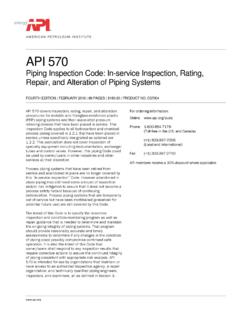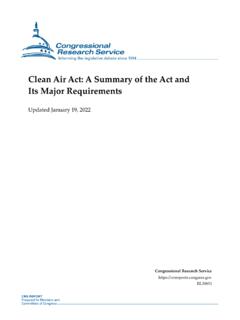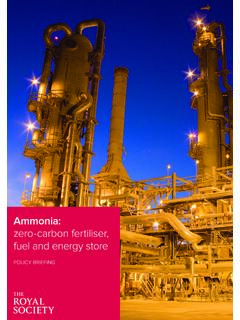Transcription of Summary of Carbon Dioxide - American Petroleum Institute
1 BACKGROUND report Summary of Carbon Dioxide Enhanced Oil Recovery (CO2 EOR) Injection Well Technology Supporting Information Provided by James P. Meyer PhD Contek Solutions 2828 West Parker Rd., Suite 102-B Plano, Texas 75075 Prepared for the American Petroleum Institute ii DISCLAIMER This report was prepared by Contek Solutions for use by the American Petroleum Institute (API). The information in this report does not necessarily reflect the views and opinions of API. API makes no warranties, express or implied, as to the accuracy of the information contained in this report . Users of this report should use their own discretion to determine whether to rely on any of the information contained herein. Any policy-related questions regarding this report should be directed to Steve Crookshank and technical questions directed to Andy Radford iii Table of Contents 1. History and Current Status of CO2 in EOR Applications Development 1 SACROC and Fields 2 Pipeline and Wells 5 Summary 6 2.
2 CO2 EOR Technical Aspects Miscibility 7 Minimum Miscibility Pressure (MMP) 7 Reservoir Implications Pressure 8 CO2 Mobility & Reservoir Heterogeneity 8 CO2 EOR Screening Criteria 9 CO2 Utilization 10 3. Well Design and Mechanical Integrity Design Standards and Recommended Practices 11 Definitions 12 CO2 Injection Wellhead Conditions 14 Welllbore New Construction 15 Design 15 Cased and Open Hole Completions 17 Cement Technology 17 Corrosion Control 18 Re-Completion of Existing Wellbores 19 Performance Observations 20 Mechanical Completion 20 Materials of Construction Evolution SACROC Experience 21 Corrosion Control and Elastomers 22 Operator Experience 22 Typical Designs 22 Workovers 26 Safety and Environment Automatic Control Systems 26 Flow Isolation 27 Populated Area Wells 27 Well Control/Blowouts Drilling Operations 27 Workover Operations 28 Plug and Abandonment 28 Mechanical Integrity Testing 28 Observations on Component Integrity 29 iv Leak Detection and Well Repair Methods Tubing Leaks 29 Casing and Packer Leaks 30 Cement Concerns SACROC Experience 30 4.
3 Acknowledgements 33 5. References 34 APPENDIX 1: Texas Rail Road Commission Mechanical Integrity Test 40 Regulations APPENDIX 2: Description of API Cements and Specialty Cements 48 v Nomenclature BCF - billion (109) cubic feed of gas at standard conditions BCFD - billion cubic feet of gas at standard conditions per day bbl - barrel BOPD - barrels of oil per day oC - temperature, Celsius CaCO3 - calcium carbonate Ca(HCO3)2 - calcium bicarbonate Ca(OH)2 - calcium hydroxide CO2 EOR - Carbon Dioxide enhanced oil recovery CCS - Carbon capture and storage CO2 - Carbon Dioxide , chemical symbol CO2 EOR - Carbon Dioxide enhanced oil recovery CRA - corrosion resistant alloy CSH - calcium silicate hydrate EOR - Enhanced oil recovery GMT - giga (109) metric tons HCO3- - bicarbonate ion H2CO3 - carbonic acid H2S - hydrogen sulfide HCl - hydrochloric acid HCPV - hydrocarbon pore volume MCF - thousand (103) cubic foot of gas at standard conditions MMCF - million (106)
4 Cubic foot of gas at standard conditions MMCFD - million cubic foot of gas at standard conditions per day MMP - minimum miscibility pressure MW - electric power, mega watt MT - million (106) metric tons OOIP - original oil in place ppm - part per million psia - pressure, pounds per square inch absolute psig - pressure, pounds per square inch gauge PV - pore volume SO4-2 - sulfate ion STB - oil, stock tank barrel oF - temperature, Fahrenheit TCF - trillion (1012) cubic foot of gas at standard conditions TCFD - trillion cubic foot of gas at standard conditions per day WAG - water alternating gas Standard Conditions: Pressure psia Temperature 60oF vi Executive Summary The purpose of this report is to identify the technologies and operating practices that have been developed by the oil and gas industry for injecting Carbon Dioxide (CO2) for enhanced oil recovery (EOR). These technologies and practices have been developed specifically for use in CO2 EOR; however, due to anticipated similarities in operating conditions, it is thought that the oil and gas industry's experiences and learnings may be of value in considering the injection of Carbon Dioxide for the purpose of geologic storage.
5 Capture and geologic storage of Carbon Dioxide ( Carbon capture and storage or CCS) is seen as a potentially viable near term approach for mitigating global Carbon emissions provided significant legal, regulatory, and technical obstacles are addressed. Geologic storage involves injection of CO2 into underground formations. Once placed there, the expectation is that the CO2 will stay there indefinitely, thus removing it from the atmosphere. Geologic storage on the scale that is thought to be necessary will require huge new investments in equipment and infrastructure. Some estimates suggest that the amount of infrastructure necessary to perform geologic storage on a meaningful level is equivalent to the existing worldwide infrastructure associated with current oil and gas production. This includes gas treatment facilities for CO2 capture, pipelines and compression equipment for transportation, and more compression equipment, distribution lines, flowlines and wells for injection.
6 Because of the magnitude of investment that may be made, it is also vitally important that any legal and regulatory infrastructure that is developed encourage safe, efficient, and environmentally sound geologic storage projects that balance costs and benefits. The oil and gas industry has over 35 years of continuously developing experience in transporting and injecting CO2 for enhanced oil recovery (EOR). While constantly evolving, the technology operating experience, and regulatory requirements that have been developed for EOR are extensive. In the United States alone, the oil and gas industry operates over 13,000 CO2 EOR wells, over 3,500 miles of high pressure CO2 pipelines, has injected over 600 million tons of CO2 (11 trillion standard cubic feet) and produces about 245,000 barrels of oil per day from CO2 EOR projects. Clearly, the technology and operational practices used by the oil and gas industry in handling and injecting CO2 can be considered a valuable resource in planning CCS projects.
7 Among the numerous technological and engineering advances made over the past 35 years in CO2 injection well design include: Corrosion resistant materials such as stainless and alloy steels (316 SS, nickel, Monel, CRA, etc.) for piping and metal component trim, vii Swell resistant elastomer materials such as Buna-N and Nitrile rubbers for downhole packers, and Teflon (PTFE) and Nylon for seals, Fiberglass lined (GRE) and internally plastic coated pipe (IPC) (phenolics, epoxies, urethanes and novolacs) tubing strings to retard corrosion, Acid resistant cements containing latex, pozzolan, alumina and other additives, Automatic control systems that not only regulate flows but also provide real-time monitoring capable of initiating well shutdowns should an unsafe condition be detected. A Summary of the materials of construction (MOC) commonly used for individual CO2 injection well components is presented below: Materials of Construction (MOC) for CO2 Injection Wells Component MOC Upstream Metering & Piping Runs 316 SS, Fiberglass Christmas Tree (Trim) 316 SS, Nickel, Monel Valve Packing and Seals Teflon, Nylon Wellhead (Trim) 316 SS, Nickel, Monel Tubing Hanger 316 SS, Incoloy, Tubing GRE lined Carbon steel, IPC Carbon steel, CRA Tubing Joint Seals Seal ring (GRE), Coated threads and collars (IPC) ON/OFF Tool, Profile Nipple Nickel plated wetted parts, 316 SS Packers Internally coated hardened rubber of 80-90 durometer strength (Buna-N), Nickel plated wetted parts Cements and Cement Additives API cements and/or acid resistant specialty cements and additives in Appendix 2 Complementing the foregoing hardware innovations has been the development of operational and safety practices, including.
8 Viii Use of corrosion protection of the casing strings via impressed and passive currents and chemically inhibited (oxygen, biocide, corrosion inhibitor) fluid in the casing-tubing annulus, Use of special procedures for handling and installing the production tubing to provide gas tight seals between adjacent tubing joints and eliminate coating or liner damage, Use of tubing and casing leak detection methods and repair techniques, using both resin and cement squeeze technologies as well as insertion of fiberglass and steel liners, Formulation and implementation of criteria unique to siting wells in or near populated areas incorporating: fencing, monitoring and atmospheric dispersion monitoring elements to protect public safety. Current industry experience shows that when these technologies and practices are used, EOR operators can expect wellbore integrity at levels equivalent to those seen for conventional oil and gas wells.
9 Additionally, there are no indications from available information that geologic integrity of the receiving formations are at risk. Core samples recovered in 2002 from a 52 year old CO2 injection well after 30 years of exposure to CO2 flood conditions verify that near geologic (reservoir cap-rock) and cement sealing integrity has been maintained48. This report provides: an overview of CO2 EOR operations, discusses technologies and operational practices mentioned above and identifies several key differences between CO2 EOR operations and potential CO2 CCS operations. The information offered in this report is presented with the intent of illustrating the types of technology and operational practices that have been developed for CO2 EOR projects, which may be adaptable to CCS projects. The information offered here illustrates technologies and practices in use by the oil and gas industry for CO2 EOR; however each project, whether EOR or CCS, should be designed to meet the site specific conditions applicable to that project.
10 The current state of CO2 injection technology can best be summarized by the conclusions reached by MIT (Massachusetts Institute of Technology) in their, Environmental Assessment of Geological Storage of CO2 1, namely that: The technologies and practices associated with geological CO2 sequestration are all in current commercial operation, and have been so for a decade to several decades. Such commercial operations include: enhanced oil recovery, acid gas (CO2) injection, natural gas storage and CO2 pipeline transportation. No major breakthrough technological innovations appear to be required for large scale CO2 transportation and storage. ix There are however, significant policy, legal and regulatory challenges that must be resolved before CCS is widely implemented. Those topics are well beyond the scope of this report . 1 History and Current Status of CO2 in EOR Applications Development During the life of a producing oil field, several production stages are encountered.

